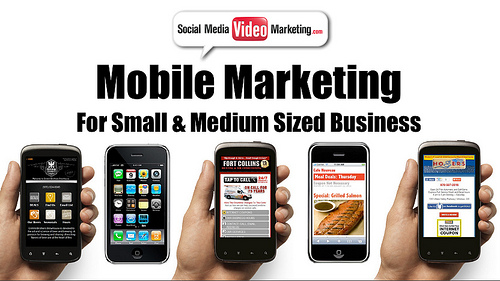Mobile Marketing

The “mobile influence factor” (or effect of smartphones on in-store sales) on retail purchases will increase to $689 billion by 2016. In 2012, 85% of merchants say mobile commerce is a focus in 2012.
With mobile internet usage surpassing desktop internet usage, your business can only stay competitive by fully engaging consumers through their smartphones.
MOBILE MARKETING OPTIONS
1. MOBILE-READY WEBSITE : It is essential your business create a mobile-ready site. What is a mobile-ready website? This is a condensed form of your main website appearing on a mobile device that is easy to view and navigate. This is essential in business today. Google publicly announced in February of 2012 company websites that do not have mobile-ready sites will be penalized in search engine optimization. While this is important, even more essential is to let your clients be able to engage your business on the most mobile platform possible. More and more searches are being done today via mobile devices. Don’t lose business to your competition. The client WILL turn to the website that IS mobile-ready and easy to navigate.
2. SMS (Short Message Service)/Text: Text messaging is one of the most powerful forms of marketing that exists today. SMS marketing requires an opt-in system. For example, an advertiser might say “Text ‘pizza’ to 34567 for a free slice”. The consumer is essentially opting in at this point and the company can send them a coupon in return. The advertiser now has the ability to send promotional material to that mobile user in the future. The number 34567 in our example is a “short code” and can be an expensive number to obtain. Many small business owners will share short codes with other businesses to cut costs.
3. MMS (Multimedia Message Service): Similar to SMS marketing, MMS messages can be more advanced and include photos, video or music. This can be extremely effective if your multi-media content converts into sales. Some mobile customers may be charged additional fees to view this kind of content so you have to weigh the pros and cons before deciding on this option.
4. QR (Quick Response) Codes: You might have seen QR Codes on products or advertisements already. They are little white square boxes with a unique stamped pattern (usually black in color). Advertisers inscribe various messages into these codes and when a mobile user snaps a photo of the code, they are subsequently sent the embedded message. Many consumers find a sense of curiosity and mystery when it comes to QR Codes. They want to scan the code so they can see what is “on the other side”. In some cases it could be a special discount or coupon. In other cases it may be additional information about the product they are investigating. Either way, QR Codes are a very powerful way of extending your mobile marketing efforts.
5. Mobile Banner Ads: Similar to buying banner ads on websites, blogs or search engines, mobile ads can be purchased and targeted towards select audiences. In general, mobile banner ads will stand out more than typical online banners and statistically mobile banner ads will receive a higher click through ratio. You can buy banner ads using pay per click or pay per exposure. Each campaign is different and you have to choose based on the needs of the market and the advertiser.
Contact us today for your free one hour social media management consultation.
